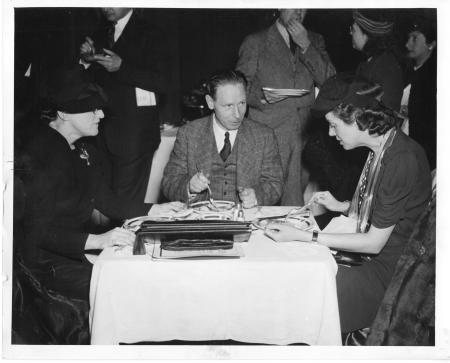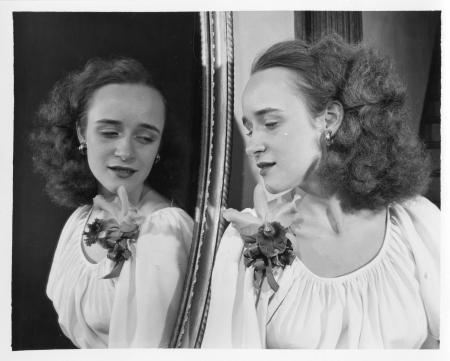Seventy years ago, on August 6 and 9, 1945, the world witnessed the birth of the Atomic Age, and journalists scrambled to explain the science underpinning the newfound power. At Science Service, a Washington, D.C., news organization, those days in early August were especially frantic.
Watson Davis, the director and principal writer, had been traveling abroad all year on government business. In his absence, his wife, Helen Miles Davis, editor of the magazine Chemistry, had taken on increasingly more duties in the news office and was also corresponding regularly with their 21-year-old daughter Charlotte, who was working for a U.S. Navy laboratory and had just been transferred to a facility in Rhode Island. The letters between Helen and Charlotte, part of a newly processed collection at the Smithsonian Institution Archives, are filled with family news - until the first week in August 1945.

Charlotte's letter to her mother on August 7, began with an ebullient account of a beach outing with family friends the previous day. Then, on the second page, she described how youthful nonchalance gave way to adult comprehension of what had happened in Japan:
I see by the papers that the atomic bomb has come of age ... The first I saw of the news was on the bus at Providence last night. A small boy came aboard selling the Boston Record which was headlined 'Atomic Bomb Terror.' I regret to say that with all my previous knowledge and good guesses about Shangri-La [insiders' slang for Los Alamos] and 'that other place in Tennessee' [Oak Ridge] I merely said to myself 'Oh well, the Record!' and went to sleep. Not until I saw the Providence Journal and the New York Times did the import of the matter dawn on me.
Helen replied to her daughter on August 9, 1945:
Dearest Bootsie: ... I have been trying to write you for a number of days, but, as you can guess, the atomic bomb has us running in circles. We want to write to WD [Charlotte's father Watson Davis] 'Having an awful time, wish you were here.' We understand the official announcement of what the bomb really is comes out today. Then the headaches really start. So I hasten to get this off now.
Helen attended to practical issues, such as Charlotte's bank account, and then added:
I'm sorry to answer your nice letter with this. Some day I'll get time for a better one. I'll mail you our [news] releases from the office. I'm not proud of them. We erred on the side of being conservative, which may be just as well in the long run. ... I turn out to be Science Service's only staff writer on atomic physics! I feel more like Hamlet every day: 'Oh, wretched spite, That I was ever born to set them right!'
Two days later, on August 11, 1945, Helen took time to write Charlotte at length:
Dearest Bootsie: Having practically disintegrated along with the atom all this week, Science Service is taking a few hours this afternoon to relax before starting on the next spurt. I wrote you from the thick of the fight that I wasn't very proud of our coverage. But after seeing what the rest of the world did with the story, I think we didn't do too badly. We see, of course, all the things we couldn't get time to do.
By then, Helen, medical editor Jane Stafford, and psychology editor Marjorie van de Water had spent two days writing stories based on the official report about the Manhattan Project (later referred to as the "Smyth Report," after its author Henry DeWolf Smyth):
The stories up to Friday came from the bare announcement that the atom had been disintegrated. Friday afternoon the technical report was released by the War Department. It is one of the amazing documents of all time. It is multilithed [lithographed], and over an inch thick. We got two copies. One we kept intact, the other we pulled the staples out of, so we could work on parts of it all at once. Jane Stafford, I think, has read all the chapter headings through consecutively, for she set herself that task. The rest of us just pick up any sheet at random and find at least one story that has to be written now, without bothering with anything else. I think the thing as a news report will balloon for about a month, for people will keep finding new angles to write about, to say nothing of all the discussion the stories will cause.
The two new chemical elements is quite a story in itself. I tried to do justice to that on Friday. There are lots more angles to write about, including the alchemist's dream and what effect it will have on the social structure if it is already here.
Helen later learned that Watson had been in Venezuela in early August and that he had not received their previous communications. On September 2, 1945, Helen wrote to him in Mexico City, summarizing how the skeleton staff had "covered the atom":
... so much has happened, I probably can't do more than hit the highest spots. ... First and biggest, of course, was the atom bomb. We will probably never be the same again! The story broke Monday morning, with the President's announcement. We had the War Department releases, but Frank [Thone, the senior biology editor] was sitting on them, in a complete dither, but writing like mad. Nobody dared interrupt him. He finally yelled to me to do a piece on the atom and what it is. His story and mine were all that made the DMR [Science Service's syndicated Daily Mail Report, sent to clients via wire] that day.
By Tuesday we learned that the War Dept. was to release the complete report Thursday, so we decided to write what background we could but not get too far out on a limb. Fortunately! The Smyth Report actually did not get out until Friday, but it is beyond all imagining. It is THE document of the age, and makes all physics and chemistry B.A.B. (Before Atom Bomb, of course) completely obsolete. If, indeed, you haven't already read it in manuscript, you will be as ga-ga as everybody else when you get hold of it.
Dave Dietz [David Dietz, science journalist for the Scripps-Howard chain] went all out on predictions in a series he wrote before the Smyth Report came out, which was published after the Report, and he couldn't have been wronger if he had tried. Nothing he wrote is true!
Friday afternoon Frank [Thone] went to Boston. Dr. Monahan was away on the radar story, which was being released just then. Martha Morrow was on vacation, though she cut it short to come back and help. ... for a time, which seemed then just a few minutes short of eternity, there was nobody but Jane [Stafford], Marjorie [Van de Water], and me to carry on. When we three get together and pool our talents, you'd be surprised what a good physicist we make!
... I think we did pretty well, all things considered, but not brilliantly. We probably handled it all on too high-brow a plane. Blakesley [Howard W. Blakeslee, Associated Press science writer] did a very much simplified job, and at first I wished we had done that sort too, but he got awfully muddled up with an oven that isn't an oven with a fire that isn't a fire which is just like oxidation only it isn't oxidation etc. etc.
I am making up the entire September issue of CHEMISTRY out of the Smyth Report. It is beautifully written and as exciting as a detective story, and the War Department is begging people to reprint it 'in whole or in part.' I rearranged it and wrote connecting paragraphs, and I think you'll like it. We are apparently scooping everybody, including Princeton Press, in getting it out.

Helen's letter continued, with office business and the news that Charlotte was home from Newport but still "on the job at NOL" [Naval Ordnance Laboratory] and that Charlotte and Calvin Mooers were "talking about getting married."
That young couple would, in fact, be central participants in science's next major social influence. Calvin, Helen wrote to her husband, "is full of plans for a new computer he has an idea for, which will do all the Aiken computer [Howard H. Aiken's Mark I] can do but do it faster, in a space about the size of an office desk. It sounds good."
Related Resources
- Smyth Report, Wikipedia and full text of Smyth Report
- Jane Stafford on The Bigger Picture blog, Smithsonian Institution Archives
- Majorie van de Water on The Bigger Picture blog, Smithsonian Institution Archives
Related Collections
- Science Service collections at the Smithsonian Institution Archives
Produced by the Smithsonian Institution Archives. For copyright questions, please see the Terms of Use.

Leave a Comment